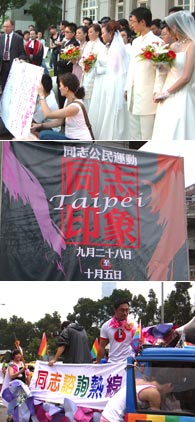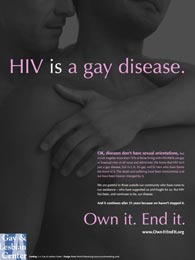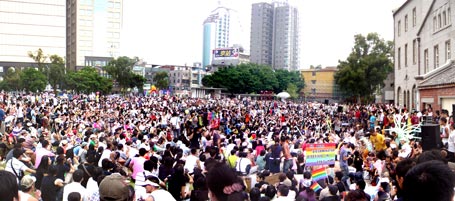Taipei Pride Parade draws largest crowd to date
Touted as Asia's largest event of its kind, Taipei Pride's annual parade drew up to 10,000 participants to walk the distance between Songshan Cigarette Factory and Huashan Culture Park last Saturday. After a string of forums, exhibitions, and workshops, the parade marked the culmination of Taipei Pride Festival which begun two weeks ago with a flag-raising ceremony in front of Taipei City Hall.

A giant rainbow flag held aloft by numerous volunteers led the procession, followed by cars sponsored by local clubs and organisations, of which many featured family-oriented themes. 2Her Publishing's "Lesbian Kitchen," for example, featured women pushing shopping carts to emphasise domestic bliss, while elsewhere the gay group "Water Boys" wore tan-baring speedos to subvert local stereotypes equating gays to anemic drug addicts.
The atmosphere was decidedly festive despite overcast skies, with much flag-waving and dancing as the crowd wound its way westwards.
"We are here to show that being gay is nothing to be ashamed of, and that we can and will show our faces!" said Sylvia Chen, one of the participants who joined the parade to support her friends.
Indeed, while allowed only a single lane of road, the procession drew the rapt attention of weekend shoppers and workers alike, most of who halted in their tracks to watch. Nor were the participants limited to local Taiwanese. To be found amongst the crowd were language students from the National Taiwan Normal University, English teachers from Canada, and activists from Japan, Singapore, and Hong Kong.
When asked what he thought of the parade, Kyle Belzer, a teacher from Detroit, Michigan, said that while the parade was expectedly much smaller than equivalents in cities such as New York or Chicago, he was surprised at the number of people participating. "This being still a pretty conservative country, I wasn't expecting this many people," he said, conceding too that the final numbers may be even higher than meets the eye given the length of the route. At this rate, he added with wry amusement, "the government might just have to close down the entire road next year."
The parade, though the most visible and publicised event, was hardly the only to be held in conjunction with Taipei Pride that day. At Huashan Culture Park, organisers publicly wed four lesbian couples, a first in Asia for collective gay weddings. Holding the ceremony was a pastor from the Tong Kuang Light House Presbyterian Church, with Wang Ping, secretary-general of the Gender/Sexuality Rights Association, and JJ Lai, owner of the city's iconic Gin Gin Bookstore, acting as emcees.
The four couples, wearing wedding dresses and tuxedos, exchanged vows as the thousand-strong crowd cheered on, a number of which held signs such as "Happily Married" or "Lesbians Unite." Though gay marriages are still illegal in Taiwan, the ceremony was held in full accordance to the rituals of a Christian wedding, complete with witnesses and a tossing of the bridal bouquets.
After the wedding, the main actors of upcoming gay film Eternal Summer made an appearance, followed by a drag rendition of Chicago as performed by local artists Da-Bing and Xiao-Bing.
Elsewhere in the park, the city government's Department of Civil Affairs continued its "Gay Impressions" art exhibition, of which highlights included prints by Hong Kong artist Lily Lau and Jiang Jing-Fang's photo documentary of drag queens. The park's "Art Boulevard," on the other hand, played host to the Rainbow Market, a bazaar with stalls selling everything from gay literature to handicrafts.
Despite original plans to have the day end with a music festival, organisers had to cancel at the last minute citing poor ticket sales and financial reasons. Originally intended to provide an incentive to stay post-wedding and performances, the music festival was to have featured local DJ's and separate floors for gays and lesbians. Judging by the number of people thronging the market stalls way past its stated closing - the organisers need not have worried. - Philip Hwang, Taipei.
Related article:
taipei holds rainbow flag raising ceremony to mark start of gay pride
HIV=gay disease? New HIV/AIDS ad creates controversy
For over twenty years, gay rights organisations and HIV/AIDS prevention groups have fought tooth and nail against the stereotype that HIV is a gay disease by the influential Los Angeles Gay and Lesbian Center last week launched a billboard campaign declaring: "HIV is a gay disease. Own It. End It."

The message of the new campaign is a complete about-turn from years of campaigning against the stereotypical view that homosexual men are promiscuous, unsafe and most likely to become infected.
The Center has notably always practiced an outspoken brand of outreach and awareness, from its ongoing sponsorship of the California AIDS Rides and successor AIDS Life/Cycle events to numerous ongoing counseling, health-awareness and aid programs.
Explaining its decision on doing an about-turn, the Centre explained in an FAQ on its web site, ownitendit.org: "Today everyone knows that heterosexuals can also get HIV. Yet in Los Angeles and throughout California, it's gay and bisexual men who constitute a hugely disproportionate number of those living HIV/AIDS."
Supporters of the ad campaign say the focus on women and other vulnerable groups in the fight against HIV/AIDS has left many MSM with a false sense of protection from the disease, even though they still account for the majority people living with the virus in the US and Europe.
Many other HIV/AIDS activists understand the intent of the campaign but don't agree with the message.
Michael Weinstein, head of the Los Angeles-based AIDS Healthcare Foundation however quoted by Los Angeles Times as asserting that AIDS was not a "gay" disease but "a disease of the immune system."
Some other AIDS counselors are however worried the campaign will further stigmatise the disease, excludes MSM who do not consider themselves gay, make heterosexual men and women reluctant to seek testing and treatment, and further reduce research funding.
Reyes Preciado, who works at the Saint Therese Center which serves more than 2,700 people touched by HIV and AIDS, however disagrees with the campaign's message that says that "HIV is a gay disease."
"It sets the community back to the ages when everyone was saying it was a gay disease, it's not a gay disease. I work with female clients, male clients and they're heterosexual."
According to the campaign web site, about 75 per cent of HIV cases in Los Angeles County occur among gay and bisexual men although they comprise less than 7 per cent of the local population.
Lorri Jean, chief executive of the Center said, "We believe that most people in our community do not understand the degree to which the epidemic continues to be in Los Angeles largely an epidemic among gay and bisexual men."
When asked if the Centre is playing into the hands of those who insist that HIV results from the "deviant" behaviour of gay men, it says: "No, we are being honest about the nature of this epidemic in Los Angeles. We cannot and must not allow the homophobia of those who oppose adequate funding for HIV treatment, prevention, and support to intimidate us from speaking the truth. Silence remains our most powerful enemy."
Related site:
ownitendit.org
Male genital hygiene may lower HIV risk
According to two papers in the September issue of Journal of AIDS, practicing regular genital hygiene in males may reduce the risk of HIV infection. The latest study is based on the previous findings that have linked male circumcision with the reduced prevalence of HIV.
According to Dr Nigel O'Farrell, from Ealing Hospital in London, and colleagues, interventions to improve genital hygiene may also effective in reducing HIV infection risk.
Based on their study of 386 uncircumcised men residing in or near Durban, South Africa, who did not suffer any genital lesions or discharge, the researchers who examined the men observed that half had some degree of wetness around the penis. Approximately 80 percent were judged to be slightly wet, 19 percent as wet, and 2 percent as very wet. In contrast, only one of 36 circumcised men they examined had wetness.
Researchers noted that HIV infection was 66.3 percent more common among the men with penile wetness, compared to 45.9 percent in men with no wetness. The degree of wetness had no affect over the risk of infection.
The authors also noted that the HIV prevalence among uncircumcised men without penile wetness was close to that of circumcised men (42.9 percent).
They theorised that the presence of "subpreputial penile wetness" - a lanolin-like wetness commonly found under the foreskin in most uncircumcised men - would increase risk, and that washing to keep the area under the foreskin dry would reduce risk.
Although many of the factors associated with penile wetness were poverty-related, Dr O'Farrell's group suggests that "information, education, and communication programs at a number of levels would be needed: for instance, encouraging washing related to sexual activity - precoital or postcoital or as an everyday life skill."
In the second Journal report, Dr King K. Holmes, from Seattle's Harborview Medical Center, and associates interviewed 150 men living in Kenya regarding socioeconomic status and hygiene practices; 15 percent were HIV positive, and 97 percent were circumcised.
Components of hygiene associated with risk included the amount of time spent in a bath (more than 10 minutes) and bathing immediately after sex.
Multivariate analysis revealed three independent risk factors for HIV infection: previous treatment for a serious illness, circumcision, and genital hygiene.
Multivariate analysis revealed three independent risk factors for HIV infection: previous treatment for a serious illness, circumcision, and genital hygiene.












 列印版本
列印版本










讀者回應
History of Taiwan Pride Parade:
http://en.wikipedia.org/wiki/Taiwan_Pride Clip from 2006 Taiwan Pride Parade:
http://www.im.tv/VLOG/Personal.asp?Memid=312983&FID=729450
Tell this to the South African Minister of Health (the study was carried out in Durban, South Africa). But hey, according to the South African Minister of Health, if you eat veggies and fruit, you won't catch HIV ... argghhh! :-(
come one
hiv is not a gay disease
give me a break
straight woman or men also can get it
geez this headline really makes me angry!
http://youtube.com/watch?v=HGDoKEwXqFU
Why do we need to say HIV is a gay disease? We have so effectively de-coupled the epidemic from the word "gay" that most of us don't even know the degree to which we are impacted. If we have learned anything in the past 25 years, it is that we must speak the truth no matter how uncomfortable some may find it. And the truth is that in Los Angeles, gay and bi men continue to bear the overwhelming brunt of the epidemic and to get infected at alarming rates.
More: http://www.ownitendit.org/whythiscampaign.html#faq
What the campaign is saying that whilst 75% of infections and new cases are from gay/bisexual men that it is predominately a gay disease.
If we as a community can reduce the gay number to below half of the total of new cases each year then it no longer becomes a gay disease, it then becomes just a disease.
Maybe then all the governments around the world will start throwing real money into research and prevention.
I think it is a great campaign.
請先登入再使用此功能。